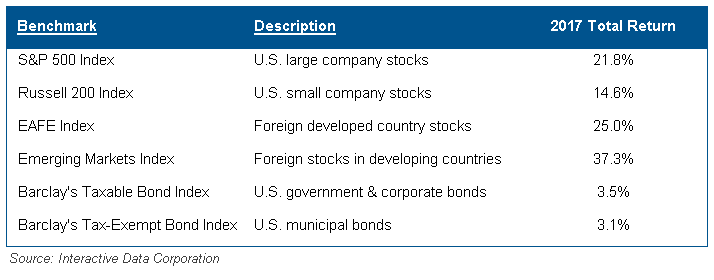Market Commentary ~ January 2018

Everything Worked!
2017 was great for investors. All major asset classes provided positive returns. Moreover, stock market performance was very steady, with no meaningful setbacks during the year. The benchmark S&P 500 Index of U.S. stocks recorded gains in every month of the year, setting a record for consistency. Progress was even better in foreign markets, where volatility was also low. Bond returns, while lower, exceeded inflation and money market returns.
Handicapping 2018
A new year is underway! We begin with our assessment of key factors. Green indicates positive, yellow is cautionary, and red (none of these yet) would suggest significant risk.
Global Economic Growth
Here at home, the U.S. Index of Leading Economic Indicators recently registered another new high, and this augurs continuing economic expansion. Readings from Europe and Asia are similarly encouraging. In fact, we have synchronized global economic growth for the first time in a decade, with all 45 OECD (Organization for Economic Cooperation and Development) countries experiencing progress. This is very encouraging.
Corporate Profits and Dividends
U.S. corporate profit growth in 2017 was above 10%, the strongest rate of improvement since 2011, and many companies provided generous dividend increases. This should continue in 2018. Global economic growth is the key factor, but the recently enacted tax legislation will provide added support. It is estimated that the lower corporate tax rate, by itself, could increase business profits by 6 – 7%.
Inflation
We have enjoyed low inflation for a long time, generally below 2% since the economic recovery began in 2009. But inflation seems to be percolating. An index of producer prices increased 3% year-to-year in November, the highest reading since 2012. Overall wages rose by an estimated 2.5% for 2017, and further increases are likely because job openings are at the highest level since 2000. We don’t expect “high” inflation anytime soon, but a move up to more normal levels of 2-3% seems probable and could be disruptive for markets. The Fed will need to be vigilant.
Interest Rates
Rising interest rates are often a causal factor in stock market declines. Higher rates exact a “double whammy” of sorts. Borrowing costs go up for businesses and consumers, eventually lowering economic growth potential. At the same time, higher rates make prospective bond returns more competitive, reducing the appeal of stocks. We think higher rates are likely for 2018, albeit at a moderate pace, because inflation is trending up and the Fed will be raising its policy targets.
Stock Valuation Levels
Valuation levels are at best a “neutral” factor at this juncture. Adjusted for the impact of tax reform, the S&P 500 price/earnings multiple for 2018 is somewhat above the post-WWII average of 15-16, though arguably reasonable relative to interest rates and inflation. However, longer-term measurements of valuation, based on a full economic cycle, put stocks in more exalted territory, indicating risk when the next recession occurs.
The interplay of these factors makes us think a decent year is probable, featuring returns of 6-8% for stocks and 2-4% for bonds. After a remarkably steady year in 2017, we think higher stock market volatility (occasional 5-10% setbacks) is almost a certainty for 2018. The best hedge against turbulence is to keep appropriate liquidity (cash and short-term bonds) for anticipated withdrawal requirements. With this important safeguard in place, occasional market corrections will not disrupt financial plans. Of course, rebalancing portfolios and maintaining appropriate diversification are additional imperatives for the long-term investor. As the year progresses, we will be on the lookout for any signs of excesses in either economic or market conditions. We are mindful that this growth cycle started in 2009, when conditions seemed so grim, and we know stock markets usually peak when business conditions appear most favorable.
More Good News
Catherine Miller, who joined us in September 2012, later this year will become accredited as our fourth Certified Financial Planner (CFP), having passed her final examination in November 2017. Bartlett also has 13 Chartered Financial Analysts and two Certified Public Accountants, giving us the professional horsepower to handle all facets of wealth management and financial planning.
Concluding Comments
We are honored by our 98% client retention rate and strive to provide the highest level of service for our clients. Do you know someone who might appreciate having Bartlett in their corner? If so, please recommend us to others who could benefit from Bartlett’s investment management and financial planning services.


